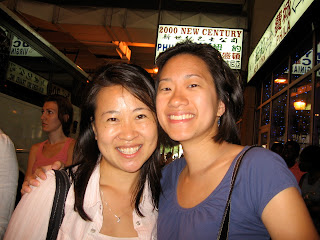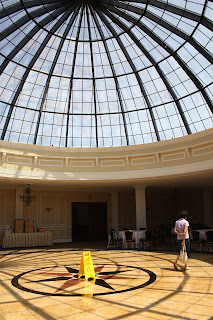I've started looking at wedding venues for the reception with my mom; we're checking out places in South Jersey, Philadelphia, and Wilmington. Even though we've already eliminated North Jersey as too expensive (hello, proximity to New York City!), all of these places on the East Coast are way-pricey. It's amazing how quickly the events salespeople can make me forget just how much money we're going to be dropping in a single evening. It's crazy! I don't think I have the courage, though, to plan a tiny wedding (family alone is over 100 people) or to elope or to plan a destination wedding so no one will come.
Now here's a fascinating alternative: the guerrilla wedding! (Cue the Dad joke: "Hey, don't say that about the bride! It's not nice!") I read about it recently in the
. I'm sure you can save money this way (provided you don't also think it's a great idea to fly out your favorite band to the bar you rented out), but would this really be less stressful?? I'm pretty sure the last thing I want to worry about on my wedding day is an encounter with law enforcement.
It's
not every day that Morag Stewart and Kevin Eggan plan a covert
operation. But on a recent morning in Breckenridge, Colo., the pair put
together a series of mysterious directions -- take the lift to the top
of the mountain, look for the guy in the red jacket -- that ultimately
led 80 of their friends and family to a clearing in the glades. It was a
logistical nightmare, but the payoff was big: It was their wedding.
Have
you been to a wedding in the woods lately? Or watched a couple tie the
knot in the middle of a shopping mall? A small but growing group of
intrepid couples are ditching the dulce de leche cake filling and glitzy
chandeliers for something a bit more, well, impromptu. They're paying
an officiant $300 to marry them in front of a prized painting at an art
museum or asking a photographer to capture them whispering "I do" in a
botanical garden before the security guards come running. The trend,
once limited to a few postrecession penny-pinchers, is now flowering
into its own full-fledged wedding-industry niche. Mary Beaty, an
officiant in New York, says inquiries for these so-called elopements or
guerrilla-style weddings have doubled in the past few years, while Jerry
Schwehm, a minister in New Orleans, is now performing three times as
many as he did five years ago. "Many of my clients run away from the
traditional, scary wedding planning," says Kim Coccagnia, a wedding
photographer in Beacon, N.Y. "They want small and intimate."
Given the
lackluster economy, you can't blame couples for skipping the usual to-do
in favor of a simpler -- and ideally cheaper -- affair. Indeed, the
average cost of a wedding totaled $25,600 last year, down 11 percent
from the prerecession high. And with more couples footing the bill
themselves, there's less pressure to "do what family expects," says
Beaty. Then there's the demographic trend: The average marriage age is
now 28 -- up from 25 in 1990. Three-quarters of these couples live
together first, which many say dials down the importance of emulating
Mom and Dad's traditional wedding. That's particularly true for some
longtime same-sex couples in states that now sanction civil unions. "We
didn't want to make a huge deal out of it, because we've been together
for almost 10 years," says Tasha Moss, who recently married her partner
at a nature center in Chicago.
But just because a couple skips the chapel doesn't mean the planning
process gets any easier. It can be tough to find pros, like
photographers and clergy, who are willing to bend the rules, and pulling
off a ceremony in a public place without drawing the wrong kind of
attention (read: hostile security guards) is no easy feat. Couples who
start down the guerrilla path to save may also find that costs add up
surprisingly quickly: Despite paying zilch for their ceremony spot,
Stewart and Eggan ended up spending close to $30,000 on their Colorado
wedding. How? By flying in their favorite Boston band to play at a local
bar they rented out. Says Stewart: "It was better than paying $80 a
plate at some reception hall."
In some ways, stealth weddings are a
throwback to the early 20th century. Back then, couples often said vows
at home and then simply went to dinner. It wasn't until the 1950s that
the bridal industry emerged and started wooing brides with fantasies of
white weddings, says Stephanie Coontz, author of Marriage, a History. Of
course, now couples don't blink when the $54 billion industry tells
them to spend a year planning an event that lasts six hours -- and costs
as much as a new car.
When graphic designers Carrie and
Martin Gee got engaged, they decided to plan a formal affair in the
gardens of the Boston Public Library. But as the questions about
centerpieces and wedding favors started to stream in, they began to
reconsider. "We looked at each other and asked, 'Is this really worth
the stress?'" says Carrie. The Gees forfeited most of their library
deposit and, several months later, walked into the Museum of Modern Art
in New York City. (Coats hid Carrie's dress and Martin's tux.) With five
family members, they stood in front of Vincent van Gogh's Starry Night
and said their vows. "People realized what was going on and started
applauding," Carrie says.
Of course, trading vows in front of a Dutch master isn't usually
quite as simple as all that. The best guerrilla weddings, pros say,
require plenty of coordination. Couples typically start by scouting a
potential locale to see if it could feasibly host a ceremony. Often,
they find that if they pick a slow time like, say, 2 p.m. on a Friday,
there's less chance of getting caught. Then they must track down an
officiant who'll agree to an unsanctioned event. As the date gets
closer, couples choose whom to invite (less than a dozen people tends to
work best), what instructions to give guests (arrive in groups of two
to avoid suspicion) and what to say, should staffers ask questions. In
Colorado, for example, Stewart and Eggan set up a group rate on
chairlift tickets by claiming they were having a family reunion. "They
kept telling guests, 'Don't ask any staff where the wedding is,'" says
Jennifer Ballard, the couple's photographer.
There's a good reason for caution:
Some venues don't allow impromptu ceremonies. The Museum of Modern Art,
for example, does not permit weddings and says couples will be asked to
leave if they're discovered. Disney World also bans them -- unless it's
an official "Disney Wedding," which can cost more than $65,000 for a
customized affair (Cinderella's crystal coach: optional). And it's not
just venues that object to the idea; more-traditional folks may find
that reciting vows in front of a large group carries more weight than a
private ceremony, says Rachel Sussman, a marriage therapist and the
author of The Breakup Bible.
Even the best-planned event can hit a snag. Ericka Tucker and Drew
Tompkins set up a webcam at their ceremony at Los Angeles's Union
Station, so family could watch via the Web. But when security guards
spotted the couple's laptop, they cut the ceremony short. (A Union
Station spokesperson says the courtyard where the ceremony took place is
available for weddings but costs $6,000 to rent.)
Couples also run into problems with family over the ultrasmall guest
list these affairs typically require. "It didn't matter that my mom's
cousin happens to live in Chicago," says Moss, the Windy City eloper.
"We didn't invite her." To soften the blow, Moss and her partner, Mel
Morelli, arranged postwedding family dinner parties in several cities.
Other couples have used a similar strategy and report that it can help
soothe hurt feelings -- as well as jack up the bill.
Ultimately, wedding pros say, a successful guerrilla wedding often
comes down to one thing: realistic expectations. Beaty, the officiant,
says she recently found herself placating a bride who got mad when she
heard she couldn't haul a portable arbor into Brooklyn Bridge Park. Says
Beaty: "I don't think she understood the idea of being quiet and
discreet."
.JPG)


.JPG)


































